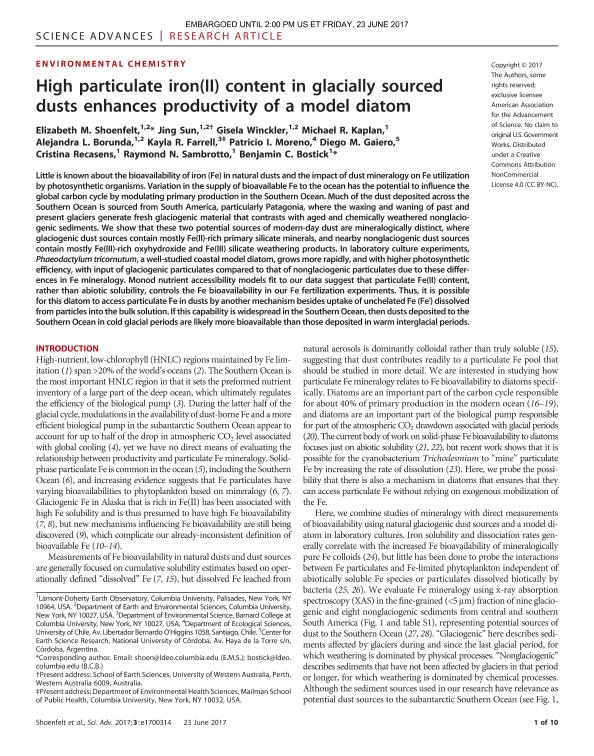Mostrar el registro sencillo del ítem
dc.contributor.author
Shoenfelt, Elizabeth M.
dc.contributor.author
Sun, Jing
dc.contributor.author
Winckler, Gisela
dc.contributor.author
Kaplan, Michael R.
dc.contributor.author
Borunda, Alejandra L.
dc.contributor.author
Farrell, Kayla R.
dc.contributor.author
Moreno, Patricio
dc.contributor.author
Gaiero, Diego Marcelo

dc.contributor.author
Recasens, Cristina
dc.contributor.author
Sambrotto, Raymond N.
dc.contributor.author
Bostick, Benjamin C.
dc.date.available
2018-05-22T18:35:28Z
dc.date.issued
2017-06
dc.identifier.citation
Shoenfelt, Elizabeth M.; Sun, Jing; Winckler, Gisela; Kaplan, Michael R.; Borunda, Alejandra L.; et al.; High particulate iron(II) content in glacially sourced dusts enhances productivity of a model diatom; American Association for the Advancement of Science; Science Advances; 3; 6; 6-2017
dc.identifier.issn
2375-2548
dc.identifier.uri
http://hdl.handle.net/11336/45886
dc.description.abstract
Little is known about the bioavailability of iron (Fe) in natural dusts and the impact of dust mineralogy on Fe utilization by photosynthetic organisms. Variation in the supply of bioavailable Fe to the ocean has the potential to influence the global carbon cycle by modulating primary production in the Southern Ocean. Much of the dust deposited across the Southern Ocean is sourced from South America, particularly Patagonia, where the waxing and waning of past and present glaciers generate fresh glaciogenic material that contrasts with aged and chemically weathered nonglaciogenic sediments. We show that these two potential sources of modern-day dust are mineralogically distinct, where glaciogenic dust sources contain mostly Fe(II)-rich primary silicate minerals, and nearby nonglaciogenic dust sources contain mostly Fe(III)-rich oxyhydroxide and Fe(III) silicate weathering products. In laboratory culture experiments, Phaeodactylum tricornutum, a well-studied coastal model diatom, grows more rapidly, and with higher photosynthetic efficiency, with input of glaciogenic particulates compared to that of nonglaciogenic particulates due to these differences in Fe mineralogy. Monod nutrient accessibility models fit to our data suggest that particulate Fe(II) content, rather than abiotic solubility, controls the Fe bioavailability in our Fe fertilization experiments. Thus, it is possible for this diatom to access particulate Fe in dusts by another mechanism besides uptake of unchelated Fe (Fe′) dissolved from particles into the bulk solution. If this capability is widespread in the Southern Ocean, then dusts deposited to the Southern Ocean in cold glacial periods are likely more bioavailable than those deposited in warm interglacial periods.
dc.format
application/pdf
dc.language.iso
eng
dc.publisher
American Association for the Advancement of Science

dc.rights
info:eu-repo/semantics/openAccess
dc.rights.uri
https://creativecommons.org/licenses/by-nc-sa/2.5/ar/
dc.subject
Dust
dc.subject
South America
dc.subject
Iron
dc.subject
Glacial
dc.subject.classification
Meteorología y Ciencias Atmosféricas

dc.subject.classification
Ciencias de la Tierra y relacionadas con el Medio Ambiente

dc.subject.classification
CIENCIAS NATURALES Y EXACTAS

dc.title
High particulate iron(II) content in glacially sourced dusts enhances productivity of a model diatom
dc.type
info:eu-repo/semantics/article
dc.type
info:ar-repo/semantics/artículo
dc.type
info:eu-repo/semantics/publishedVersion
dc.date.updated
2018-05-09T16:16:04Z
dc.identifier.eissn
0036-8075
dc.journal.volume
3
dc.journal.number
6
dc.journal.pais
Estados Unidos

dc.description.fil
Fil: Shoenfelt, Elizabeth M.. Columbia University; Estados Unidos
dc.description.fil
Fil: Sun, Jing. Columbia University; Estados Unidos
dc.description.fil
Fil: Winckler, Gisela. Columbia University; Estados Unidos
dc.description.fil
Fil: Kaplan, Michael R.. Columbia University; Estados Unidos
dc.description.fil
Fil: Borunda, Alejandra L.. Columbia University; Estados Unidos
dc.description.fil
Fil: Farrell, Kayla R.. Columbia University; Estados Unidos
dc.description.fil
Fil: Moreno, Patricio. Universidad de Chile; Chile
dc.description.fil
Fil: Gaiero, Diego Marcelo. Consejo Nacional de Investigaciones Científicas y Técnicas. Centro Científico Tecnológico Conicet - Córdoba. Centro de Investigaciones en Ciencias de la Tierra. Universidad Nacional de Córdoba. Facultad de Ciencias Exactas Físicas y Naturales. Centro de Investigaciones en Ciencias de la Tierra; Argentina
dc.description.fil
Fil: Recasens, Cristina. Columbia University; Estados Unidos
dc.description.fil
Fil: Sambrotto, Raymond N.. Columbia University; Estados Unidos
dc.description.fil
Fil: Bostick, Benjamin C.. Columbia University; Estados Unidos
dc.journal.title
Science Advances

dc.relation.alternativeid
info:eu-repo/semantics/altIdentifier/url/http://advances.sciencemag.org/content/3/6/e1700314
dc.relation.alternativeid
info:eu-repo/semantics/altIdentifier/doi/http://dx.doi.org/10.1126/sciadv.1700314
Archivos asociados
